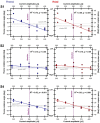Cervical myogenic potentials and controlled postural responses elicited by a prototype vestibular implant
- PMID: 31396689
- PMCID: PMC6722147
- DOI: 10.1007/s00415-019-09491-x
Cervical myogenic potentials and controlled postural responses elicited by a prototype vestibular implant
Abstract
Gaze stabilization and postural control are two key functions of the vestibular system. In consequence, oscillopsia and chronic imbalance are the two main complaints of patients presenting with a severe bilateral vestibular function loss. The vestibular implant is emerging as a promising treatment for this group of patients whose quality of life is significantly impaired. Although the final aim of the vestibular implant should be to restore vestibular function as a whole, until now the research has focused mainly on the restoration of the vestibulo-ocular reflex to improve gaze stabilization. In this study, we aimed to explore whether the vestibulo-collic and vestibulo-spinal pathways could be activated and controlled with the electrical stimuli provided by our vestibular implant prototype. This was first explored and demonstrated with recordings of electrically elicited cervical vestibular evoked myogenic potentials (ecVEMPs). ecVEMPs with characteristics similar to the classical acoustically elicited cervical vestibular evoked myogenic potentials (cVEMPs) were successfully evoked in five out of the eight tested patients. Amplitudes of the electrically elicited N-P complex varied, ranging from 44 to 120 µV. Mean latencies of the N and P waves were of 9.71(± 1.17) ms and 17.24 ms (± 1.74), respectively. We also evaluated the possibility of generating controlled postural responses using a stepping test. Here, we showed that controlled and consistent whole-body postural responses can be effectively obtained with rapid changes in the "baseline" (constant rate and amplitude) electrical activity delivered by the vestibular implant in two out of the three tested subjects. Furthermore, obtained amplitude of body rotations was significantly correlated with the intensity of stimulation and direction of body rotations correlated with the side of the delivered stimulus (implanted side). Altogether, these data suggest that the vestibular implant could also be used to improve postural control in patients with bilateral vestibulopathy.
Keywords: Bilateral vestibulopathy; Postural control; Stepping test; Unterberger/Fukuda test; Vestibular implant; Vestibulo-spinal reflex; cVEMPs.
Conflict of interest statement
The authors have received research and travel grants from MED-EL (Innsbruck, Austria).
Figures



References
-
- Zingler VC, Weintz E, Jahn K, Mike A, Huppert D, Rettinger N, et al. Follow-up of vestibular function in bilateral vestibulopathy. J Neurol Neurosurg Psychiatry. 2008;79(3):284–288. - PubMed
-
- Guinand N, Boselie F, Guyot JP, Kingma H. Quality of life of patients with bilateral vestibulopathy. Ann Otol Rhinol Laryngol. 2012;121(7):471–477. - PubMed
MeSH terms
LinkOut - more resources
Full Text Sources
Medical
Miscellaneous

